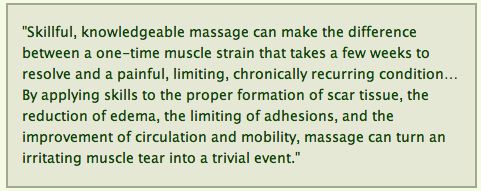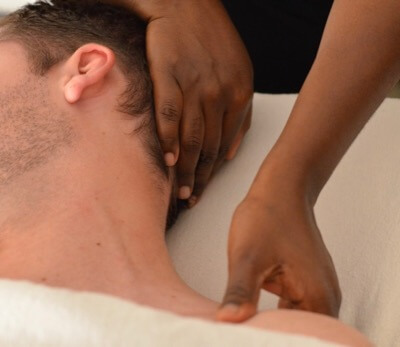- Home
- Benefits of Massage
- Injury Massage
As an affiliate for Bookshop, Amazon, and other programs, I may earn a small commission for products purchased through links. This doesn't affect the price you pay. Privacy policy and disclosures.
Search this site:
Injury Massage for Soft-Tissue Injuries
Injury massage therapy takes a targeted approach that can help soft-tissue injuries (tendonitis, whiplash, muscle pulls and strains, ligament sprains, etc.) heal faster.
Massage can help reduce pain, spasm, and swelling. Massage can also prevent formation of too much scar tissue or reduce already existing excess scar tissue and adhesions (stuck together tissue) that weaken muscles. Weak muscles can lead to another injury.
According to Ruth Werner, author of A Massage Therapist's Guide to Pathology:

Caution: Do not massage an injury in the acute phase (usually about 48 hours after the injury), as the pressure might worsen the injury. You can massage surrounding areas. Also, manual lymph drainage might be appropriate to help reduce swelling.
Massage Therapy for Injury Recovery
A muscle or other soft-tissue injury consists of small tears in the tissue fibers. Your body immediately begins to create scar tissue to heal the tears. However, this scar tissue doesn't necessarily form parallel to the injured tissue fibers, potentially leading to weak scar tissue susceptible to another injury Also, scar tissue doesn't stretch and can restrict movement of adjacent soft-tissue fibers, again possibly leading to further injury.
The goal of injury massage is to create tension and stretch that break down excess scar tissue and help new tissue fibers align with the old ones. Massage may also increase circulation around the injured area, which supports healing by bringing in nutrients and removing waste products.

Massage for injury is a process that requires regular massage, at least once a week. Some people see much quicker results with two massages a week at the start. How long will you need massage? It depends on what type of injury you have, how old it is, and your body's ability to heal. Another factor in healing is your willingness, as needed, to follow at-home care instructions, exercise or stretch the injured area, or find and get rid of the cause of ongoing injury.
Injury massage is different from relaxation massage and can leave you feeling sore for a day or two. However, a lot of pain during or after the massage isn't necessary and can be counterproductive. Always tell your massage therapist how you felt after your last massage.
Techniques commonly used in massage therapy for injury recovery include deep tissue techniques, trigger point massage and other neuromuscular techniques, active release technique, and sports massage techniques.
Also see Scar Tissue Massage.
More about massage for injury recovery:
Massage and Sports Injury Recovery
Acute Injury Management for Massage Therapists
Massage Helps Injured Muscles Heal Faster and Stronger
Personal Injury Massage Experience
My personal experience illustrates how injury treatment massage can work. Two years before I started massage school, I broke my left arm and one of the bones in my left wrist. After my arm healed, I still had wrist pain that became particularly annoying after I started massage school.
When we reached the injury treatment section of the curriculum, I asked one of the instructors to look at my wrist and she showed me which ligament to work on. I spent a few minutes three or four times a week doing cross-fiber friction massage on the ligament and then icing it. At first, I didn’t feel any change. Then about two months later, I realized my wrist no longer hurt, and I haven’t had wrist pain since.
Buy essential oils: Aromatics International or Rocky Mountain Essential Oils.




